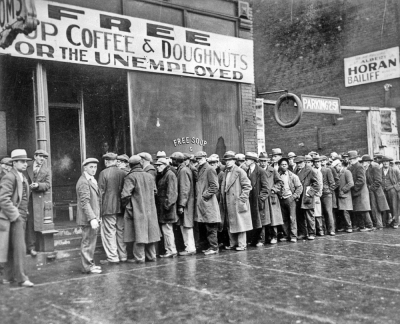
The American Depression began in September 1929 with a great collapse of the stock market in Wall Street, New York. During the money making mania which accompanied the great prosperity of the 1920s, “paper” fortunes were made and the prices of shares soared to record high levels.
President Herbert Hoover tried unsuccessfully to abate the fever. On September 7 a reaction set in and on October 24 came the great Wall Street crash. On that Black Thursday, 13,000 million shares of stock were sold and prices plunged faster than ever before.
Huge fortunes were lost by many businessmen, and the savings of millions of small investors vanished. Factories were closed, the number of unemployed rocketed, foreign trade fell, banks failed, and mortgages were foreclosed and, all the time, the prices of wheat, cotton, copper, oil and other commodities kept sinking. The buying power of the United States was paralysed.
These were the days of “Buddy, can you spare a dime?” All over the country people lined up at emergency “soup kitchens”. Young men rode freight trains looking for work and old people died of starvation. By February 1932 a full third of the American workforce was idle. The rest of the world, too, was affected and international trade dwindled to a third of its 1928 volume.
In 1933 a new president, Franklin D. Roosevelt (1933-1945) was elected. He launched the New Deal and set up a vast system of public works paid for by the state. Contractors’ orders for these schemes revived heavy industry, and workers’ wages restored prosperity to the towns. Trade unions were encouraged, tariffs lowered and many laws passed which helped to save the economy.
Picture Credit : Google




